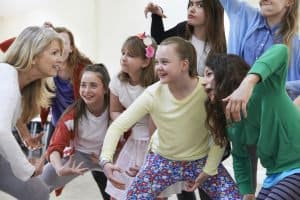 Juliet Falce-Robinson insists on individual style in a skills-based approach to language teaching
Juliet Falce-Robinson insists on individual style in a skills-based approach to language teaching
The goal of a successful language program is to foment and foster the development of linguistic and cultural proficiency, and thus awareness, that will facilitate dialogue and contribution to a global society. Language teachers continually strive to provide educational opportunities that allow students to become multilingual, multicultural, and intellectual members of the community, while inspiring an appreciation of the language and culture that extends past the classroom. Managers of school districts, states, and college and university programs select pedagogical and instructional approaches and strive to offer courses at all levels which enrich the creative, intellectual, and productive talents of the students.
Pedagogy can be defined as “the art, science, or profession of teaching.” To teach is to educate. Educare, from Latin, means “to draw out,” and it is important to look at education (and teaching) in that way, with the presupposition and recognition that the students have it in them to learn and so the challenge for the instructor is to find the ways to draw that learning out. Language instructors recognize that excellent communication skills as well as cultural literacy are essential for students as they strive for success in the future. In addition, the study of language and culture is central to the development of the individual, whose familiarity with many forms of art, creativity, and self-expression will add balance and contribute not only to the overall success of the student but also to the personal achievement and happiness of a well-rounded individual.
A successful language teacher will see his or her role as a facilitator of learning. At all levels, classroom instruction must be student centered; in other words, students work together in groups to solve problems and complete tasks.
In the Language Program in the Department of Spanish and Portuguese at UCLA, the instructional approach is student centered and proficiency oriented. Proficiency oriented refers to the measurement and assessment of projected student learning outcomes. The method is communicative, which by nature has as its goal communicative competence in the four skill areas: listening, speaking, reading, and writing. Culture is consistently incorporated through both the use of authentic materials and the integration of sociolinguistic and sociocultural behaviors to enable students to carry out tasks and communicate in situations likely to be found in the target culture. Classrooms are active and dynamic—they support and elicit critical thinking and cooperative learning. Instructors strive to create a classroom environment that is low anxiety and high energy, offering all students an equitable opportunity to engage and learn. Instruction is presented in a format that allows for a balanced mix of whole-class/instructor interaction, group work, and pair work. In language classes, all four communicative skills are practiced in each class session. The relationship between language and culture is symbiotic; therefore, the integration of cultural images, representations, and values which promote acceptance, understanding, and cross-cultural communication are integrated in all class sessions and assignments.
The use of formative assessment and feedback provides a rich context for continued learning and acquisition. Summative assessment in all four skill areas is carried out at the end of the quarter to measure the proficiency of the students against the projected outcomes. The Language Program in Spanish and Portuguese at UCLA is relatively large, with approximately 50 sections per quarter, taught by 25–35 teaching assistants and lecturers. For that reason, the program is organized in such a way as to ensure consistency across all sections and levels. All of the language courses are single-syllabus courses. All instructors must use the same syllabus, textbook, rubrics for evaluation, and assessment instruments.
All instructors are required to teach communicatively and exclusively in the target language and to integrate the practice of all four skill areas in every class session.
What about individual teaching style? Can language instructors effectively tap into and utilize their own individual skills, talents, and techniques in such a structured and prescriptive instructional environment? The answer to this question is that not only can they, but rather they must. Personalization in language teaching is fundamental to both the teaching and the learning. We know when the input is personalized—in other words, it is personally relevant and of interest to the student—there is a greater likelihood that it will be acquired. We also know that instruction must be personalized from the point of view of the instructor.
“When instructors are able to create activities by
tapping into their own backgrounds, experiences, talents, and areas of
expertise, the instruction will inevitably be more
meaningful and engaging.”
Language instructors must have the confidence and freedom to teach not only what they know but also what is important and personally relevant to them. When instructors are able to create activities by tapping into their own backgrounds, experiences, talents, and areas of expertise, the instruction will inevitably be more meaningful and engaging. Classroom spaces that are active and dynamic depend on both students and teachers being engaged, involved, and enthusiastic about the materials and activities. Language instructors, almost without exception, love the language and the culture that they teach.
At one point or another, we all began in this career because of our passion for the language and our desire to share it with others. Often, instructors get so caught up in the quantitative nature of grading, classroom management, policies, and procedures that we lose sight of the reason we are in the classroom. I often ask novice instructors to reflect on what they truly love about the language they are teaching and ask them to find a meaningful way to transmit that to the students. This, fundamentally, is at the heart of the teaching of language.
The daily lesson plan, then, becomes a template in which the instructor finds a way, every day, to show the student why the language and the culture are so exciting, so beautiful, and so worth learning more about.
The following is a sample lesson-plan template for a skills-based, communicative language class. Although the template is standardized, the instructor can (and should) personalize each activity and present the content in a way that is most consistent with his or her own personality or teaching style. The instructor is following the curriculum and teaching method but personalizes with his or her own sense of fun/humor and enjoyment of pop culture. The instructor’s notes are in italics.
Thematic Objective: The family
Communicative Objective: Describe and discuss members of the family and relationships
Linguistic Objectives: Nouns, adjectives, adjective agreement, numbers
As students arrive, play one or two favorite music videos from a singer from this country. Remember to greet each student in the target language as she arrives and ask how she is.
Warm-up (three minutes). Two to three basic questions that students can discuss with ease, based on prior knowledge. The goal of the warm-up is to get the students speaking in the target language from the start. Ask basic questions that anyone can answer about families. Use visuals on slide of famous families students are familiar with (Trumps, Kardashians, etc.).
Presentation of input (seven to ten minutes). With the use of visuals, recycle previous vocabulary, introduce new vocabulary, expansion. Use photos that represent diverse families. Incorporate families from target culture as well as pictures of my own family.
Advance organizer (one to two minutes). Brief brainstorming activity to activate background knowledge of students. Pictures of the Simpsons—have students describe the relationships between them.
Listening activity (five to ten minutes). Use authentic materials. Active listening. Remind students of listening strategy. Students should have task/questions prior to listening. Students compare answers in pairs before listening to the selection again. Video of Shakira and her husband as they discuss what the family dynamic is like in their house. Have students listen for key words and take notes. After listening, I compare my family dynamics to Shakira’s and ask them to do so with a partner.
Speaking activity (five to ten minutes). Students interview each other (topic similar to listening) and share results. Transition to students speaking more meaningfully about their own families (nothing prescriptive here—students define what a family is, who is in it, what the roles are, etc.). Each student should describe one family member in detail.
Advance organizer (one to two minutes). Brief brainstorming activity to activate background knowledge of students. Have students work together to make a list of all the types of events they have shared with their families in the last year.
Reading activity (five to ten minutes). Use authentic text. Remind students of reading strategy. Students work in pairs or groups to answer questions or complete task. Students read invitations to baptism and wedding, identify different family members and specific information. Discuss cultural traditions, use of last names.
Writing activity (ten to 15 minutes). Students work in pairs to write for a purpose. Students plan a family reunion or event. Make list of invites, prepare invitation and seating chart (based on relationships).
Speaking activity (five minutes). Signature or other fun activity to wrap up. Students work with new partners to describe a member of the family. The partner draws what he/she hears, sees how close it comes to the real person.
Language instructors, whether following state or district curricular standards or teaching in a large, highly organized college or university program, can and should tap into their own individual skills and talents to personalize instruction and make classroom exchanges more engaging, dynamic, and authentic. Draw out, facilitate, and never forget to highlight the passion for the language that brought you to teaching.
Juliet Falce-Robinson, PhD, is director of the Language Program at the Department of Spanish and Portuguese, University of California, Los Angeles.





 Juliet Falce-Robinson insists on individual style in a skills-based approach to language teaching
Juliet Falce-Robinson insists on individual style in a skills-based approach to language teaching